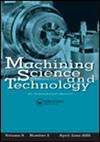Influence of milling process parameters and significance of tools to improve the surface quality of GFRP composites
IF 2.6
4区 工程技术
Q2 ENGINEERING, MANUFACTURING
引用次数: 2
Abstract
Abstract The anisotropic nature of polymer composites presents many challenges for manufacturers to adopt appropriate machining processes. In the present investigation, end milling experiments were conducted on glass fiber reinforced polymer laminates with five varieties of customized cutting tools with different angles of rake and clearance. The performance of the tools was evaluated in terms of their machining force, surface roughness and delamination factor at spindle speeds in the range of 690–2500 rpm. From the observations, relatively high rake and angled clearance tools performed better than the rest of the tools under consideration in terms of delamination and machined surface finishing. The milling operations performed at a spindle speed of 1950 rpm produced better surface quality. Observations from SEM graphs, exposed surface defects due to milling, generated at lower spindle speeds of 690 rpm and at higher spindle speeds of 2500 rpm with the tool signature of low angle rake and angled clearance tools out of all five tools considered for the experiments.铣削工艺参数对提高GFRP复合材料表面质量的影响及刀具的意义
摘要聚合物复合材料的各向异性给制造商采用合适的加工工艺带来了许多挑战。在本研究中,使用5种不同前角和间隙的定制刀具对玻璃纤维增强聚合物层合板进行了立铣削实验。在主轴转速为690-2500转/分的范围内,对刀具的加工力、表面粗糙度和分层系数进行了评估。从观察结果来看,相对较高的前角和角度间隙刀具在分层和机械表面精加工方面比其他刀具表现更好。在主轴转速为1950 rpm时进行的铣削操作产生了更好的表面质量。从SEM图中观察到,由于铣削而暴露的表面缺陷,在较低的主轴转速为690转/分和较高的主轴转速为2500转/分时产生,在实验中考虑的所有五种刀具中,刀具特征为低角度前倾角和角度间隙刀具。
本文章由计算机程序翻译,如有差异,请以英文原文为准。
求助全文
约1分钟内获得全文
求助全文
来源期刊

Machining Science and Technology
工程技术-材料科学:综合
CiteScore
5.70
自引率
3.70%
发文量
18
审稿时长
6 months
期刊介绍:
Machining Science and Technology publishes original scientific and technical papers and review articles on topics related to traditional and nontraditional machining processes performed on all materials—metals and advanced alloys, polymers, ceramics, composites, and biomaterials.
Topics covered include:
-machining performance of all materials, including lightweight materials-
coated and special cutting tools: design and machining performance evaluation-
predictive models for machining performance and optimization, including machining dynamics-
measurement and analysis of machined surfaces-
sustainable machining: dry, near-dry, or Minimum Quantity Lubrication (MQL) and cryogenic machining processes
precision and micro/nano machining-
design and implementation of in-process sensors for monitoring and control of machining performance-
surface integrity in machining processes, including detection and characterization of machining damage-
new and advanced abrasive machining processes: design and performance analysis-
cutting fluids and special coolants/lubricants-
nontraditional and hybrid machining processes, including EDM, ECM, laser and plasma-assisted machining, waterjet and abrasive waterjet machining
 求助内容:
求助内容: 应助结果提醒方式:
应助结果提醒方式:


